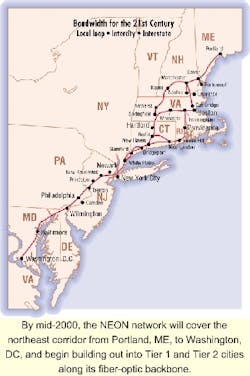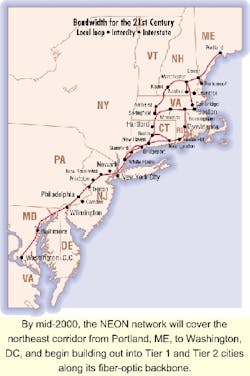NEON continues utility alliance strategy to expand fiber-miles
Access to utility rights-of-way provides distinct advantages for any fiber-optic telecommunications carrier that wants to build or extend the fiber-miles of its network. Williams Communications, managing over 100,000 miles of energy pipelines by 1985, began placing fiber cables in pipeline rights-of-way to become one of the nation's first and largest carriers' carriers by 1994.
Today, carriers' carriers are developing strategies for reaching into the lucrative metropolitan business market with their fiber, and forging mutually beneficial relationships with rights-of-way owners to gain access to these areas can catapult them ahead of the competition. NorthEast Optical Network Inc. (NEON--Westborough, MA) is getting a jump on the carriers' carrier market along the eastern corridor of the United States through this approach.
NEON, a facilities-based carriers' carrier in five New England states and New York, announced two major rights-of-way deals that will extend its existing 1000 route-mi fiber network to about 1400 route-mi from Portland, ME, to Washington, DC. The agreements were made with Consolidated Edison Communications Inc. (CEC--New York City), a wholly owned subsidiary of Consolidated Edison Inc., and Exelon (Philadelphia), a wholly owned subsidiary of Philadelphia-based PECO Energy Co."As far as fiber plant, NEON will now have approximately 80,000 fiber-mi in a geographic region that stretches from Maine to Washington, DC," says Vincent Bisceglia, chairman and CEO of NEON. "The company has a major commitment to dense wavelength-division multiplexing [DWDM] technologies. It's an OC-192 [10-Gbit/sec] backbone, and the engines we're utilizing are provided by Nortel's [Nortel Networks-Brampton, ON, Canada] DWDM transport gear. On the fiber side, we're using Lucent's [Lucent Technologies--Murray Hill, NJ] TrueWave fiber on the long haul and AllWave fiber in the metro. This combination gives us a network that is scalable to extraordinary capacity limits." The deals that are providing NEON's expanded footprint add CEC's New York coverage areas of New York City; Westchester, Orange, and Rockland counties; and portions of Putnam and Dutchess counties. Exelon brings to the table metropolitan Philadelphia and four surrounding suburban areas as well as portions of two New Jersey counties. Although the agreements are similar, Bisceglia stresses both are multifaceted and very separate.
Both agreements are based on physical assets such as fiber, collocation space, rights-of-way, payments, points-of-presence, construction, and delivery, says Bisceglia. "In addition, there are also marketing agreements that we have between NEON and both companies as to how we'll conduct our business moving forward. So we expect to generate quite a bit of traffic by working together with these marketing agreements."
CEC will obtain 10.75% of a fully diluted share of NEON to be effectively earned over time with the delivery of assets and agreements. Exelon will earn 9.25% of the fully diluted common stock of NEON via a similarly structured deal in terms of assets and agreements. Additionally, both companies will nominate a member to the NEON board of directors. The network capacity will be marketed under the NEON brand from end to end, but CEC has its own wholesale carriers' carrier business within its own operating territory and will continue to market its own wholesale services to carriers.
"These are not overlapping or competitive initiatives," says Bisceglia. "They're very much complementary. As the traffic spins off the ConEd network, it will come onto the NEON network and get carried north or south. The same type of relationship exists with Exelon."---CEC is focused on a carriers' carrier market within New York City. It is building out a metropolitan network to provide connectivity for the next mile or so between the end customer and retail provider. According to Peter Rust, president and CEO of CEC, the company plans to use the alliance with NEON to expand its New York model between cities and build them out from within.
"We're expanding the network between cities and also expect to see a lot of traffic from joint selling as a result of the alliance," says Rust. "That is, the traffic that will be terminating within the cities we're building out. So it's a way to expand beyond the city networks we're creating and a way to drive traffic from outside our geography and get some revenue from that traffic here in the ConEd footprint."
CEC believes carrier customers are seeking diversity for their network traffic and that the network CEC is deploying, being 100% separate from what is now in place, will meet their needs. A brand new build also offers other advantages.
"It gives them the ability, at least with us, to help design the network as we go along," says Felipe Alvarez, vice president of sales and marketing at CEC. "We allow them to basically put their buildings onto the network fairly easily with a brand new, 100% fiber build that is diverse. So there are a number of positives that make a utility/telecom venture fairly attractive to established telecom players."
NEON grew its network out of other electric utility backing and has developed a similar synergistic culture with its new alliances. CEC's Rust also points out that because of these synergies the companies mesh together well in terms of architecture and technologies. He believes the companies will continue to create new synergies from operations to purchasing to marketing and sales.
There's no question that aligning itself with utilities has played a major role in the growth of the NEON network. Throughout its short history, NEON has found utility rights-of-way to be private, safe, secure, and well maintained for routing fiber. The deregulation of the utility industry, says Bisceglia, played very well with the deregulation initiatives happening in the telecommunications sector.
"So we saw the commonality of our need and the utility market deregulation as being kind of a convergence point between NEON and the initial utilities that we structured deals with," says Bisceglia. "Early on, we made rights-of-way deals with PECO, Boston Edison, New England Electric, Central Maine Power, and Northeast Utilities. We view the relationship expanding contiguously through New York and onward to Washington with CEC and PECO was just a natural progression of that initial strategy."
Because of these latest deals, the future appears promising for further expansion of NEON's fiber-optic reach. According to Bisceglia, these agreements will enable accelerated network expansion. The endorsement, he adds, of two large utilities can't hurt either.
"From a customer perspective, it gives them comfort that we are aligning ourselves with more financially stable and more powerful partners in addition to our current utility relationships," says Bisceglia. "It just adds to that whole aura of stability, and I think that's critical. The way we did these deals will also enable NEON to redirect some of the capital it had raised for this expansion into other areas of intra-region. It frees up capital for metro build-outs and off-backbone builds."
Competition in most of the northeast corridor is relatively mild, although it is heating up. NEON, however, hasn't observed any major price erosion in the New England marketplace. But entering the Philadelphia and New York City metropolitan areas could require some new competitive pricing strategies. CEC and Exelon, however, have been dealing with these areas for some time and still believe the NEON venture has the upper hand.
"We're collectively putting in a brand new, state-of-the-art network which gives us some cost advantages over some of the older networks that are out there," says Rust. "But we're also targeting our services as extremely reliable services that are on 100% fiber networks that are self-healing. So we're trying not to compete as much on price-we're not trying to be the low-cost provider. We're also offering networks that are going through utility rights-of-way and are physically diverse from the other networks out there. There's a huge benefit to a lot of folks for having that diversity, and they're willing to pay premiums for that over what some of the other services are going for."

